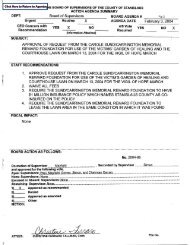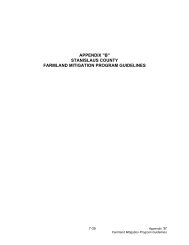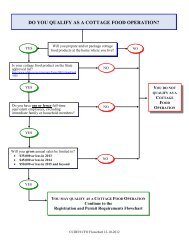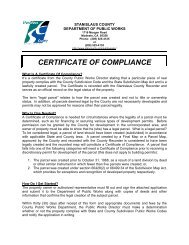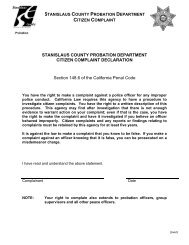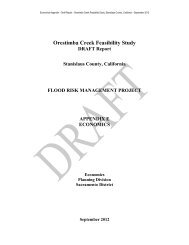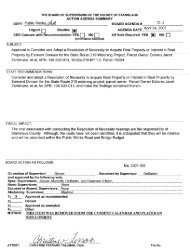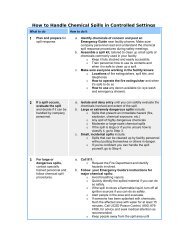Orestimba Creek Hydrology - Stanislaus County
Orestimba Creek Hydrology - Stanislaus County
Orestimba Creek Hydrology - Stanislaus County
- No tags were found...
Create successful ePaper yourself
Turn your PDF publications into a flip-book with our unique Google optimized e-Paper software.
<strong>Orestimba</strong> <strong>Creek</strong> near NewmanAccurate analysis of flood flow requires a reliable, representative time sample of randomhomogeneous events for the study location. <strong>Orestimba</strong> <strong>Creek</strong>’s arid climate and heavilyunconsolidated sediment produce non-homogeneous basin runoff characteristics. <strong>Orestimba</strong> is a lowflow threshold stream. Significantly higher losses occur on the lower flows than on the high flows.Some of this is due to the arid climate and the inability of the soils to hold moisture for an extendedperiod. This is apparent in the drainage area’s vegetative cover of mostly grasses, which quickly dieoff as spring and summer approach. Storms must be closely spaced to have significant runoff. Onlyin 1 out of 10 years, for example, is there enough runoff to sustain the growth of young Sycamoretrees in <strong>Orestimba</strong> <strong>Creek</strong>’s lower streambed below the foothills. Several other factors, factors thatcan be observed by plotting the flows on a log probability scale, lead to the conclusion that the basinrainfall-runoff response is non-homogeneous. These include the following: (1) There is a constantslope for the largest 26 out of 76 years of data ((the largest third of the flows (33% probability andless)). But this slope changes for the next third of the data and again for the last third of the data,which contain an average of 12 years of zero flows. (The slope of the data indicates its standarddeviation. A reasonably constant slope indicates homogeneity.) (2) A second factor is that 12 of 75years of recorded runoff for the basin show no flows at all. This occurred at the same time that anadjacent basin, Puerto <strong>Creek</strong>, with the same climate and similar upper basin geology had runoff foreach of <strong>Orestimba</strong> <strong>Creek</strong>’s zero flow years. The main cause is the dramatic difference in the rainfallrunoffresponse depending on antecedent rainfall and its magnitude. (3) A third factor is seen in thecomparison of the flows and statistics of the upper quartile of <strong>Orestimba</strong> <strong>Creek</strong> flows with a similarwatershed’s flows (i.e., Del Puerto). This permits the comparison of flood frequency estimates andstatistics with those that might be expected in a homogeneous region.<strong>Orestimba</strong> <strong>Creek</strong> emerges from the foothills about five miles upstream of the <strong>Orestimba</strong> <strong>Creek</strong> nearNewman gage. The shallow stream flows through moderately deep valley fill alluvium composed ofcoarse-grained unconsolidated sediments (Reference c). These unconsolidated sediments inducelarge channel losses at the beginning of the flood season, causing much of the flow for smallerevents to be adsorbed and flow under the surface of the streambed itself. As a result, many lowrainfall years show zero flow at the gage. This flow regime quickly stores early or light runoff untilthe storage capacity is satisfied. Then—and only then—is there surface runoff. As a result, 12 of the76 years of record show no flow at the gage for the drier years. The flow regime changes as channelstorage increases: the wetter the antecedent conditions and the larger the storm, the greater thepercentage of storm runoff.The <strong>Orestimba</strong> <strong>Creek</strong> near Newman analysis used the log-Pearson Type III distribution with theconditional probability adjustment option of Appendix 5 in Bulletin 17 B. This adjustment isrecommended to obtain the frequency curve for stations where the record of annual peaks istruncated by the omission of peaks below a gage base and years with zero flow and/or low outliercriteria. Bulletin 17B recommends not eliminating more than 25% of the flow. This study eliminates40% of the flows. The upper 60 percent of the data was used (highest 45 years of record) todetermine points needed to establish the statistics. Using 60% of the flows minimizes the nonhomogeneityof the flows and provides enough data to estimate the 0.5, 0.1, and 0.01 exceedenceprobabilities needed to compute conditional probability adjustment. The regional characteristics andother stream characteristics indicate that the removal of these data brings the frequency curvemoments into closer alignment with Del Puerto <strong>Creek</strong> and other streams on the west side of thevalley that have not been mentioned.12




